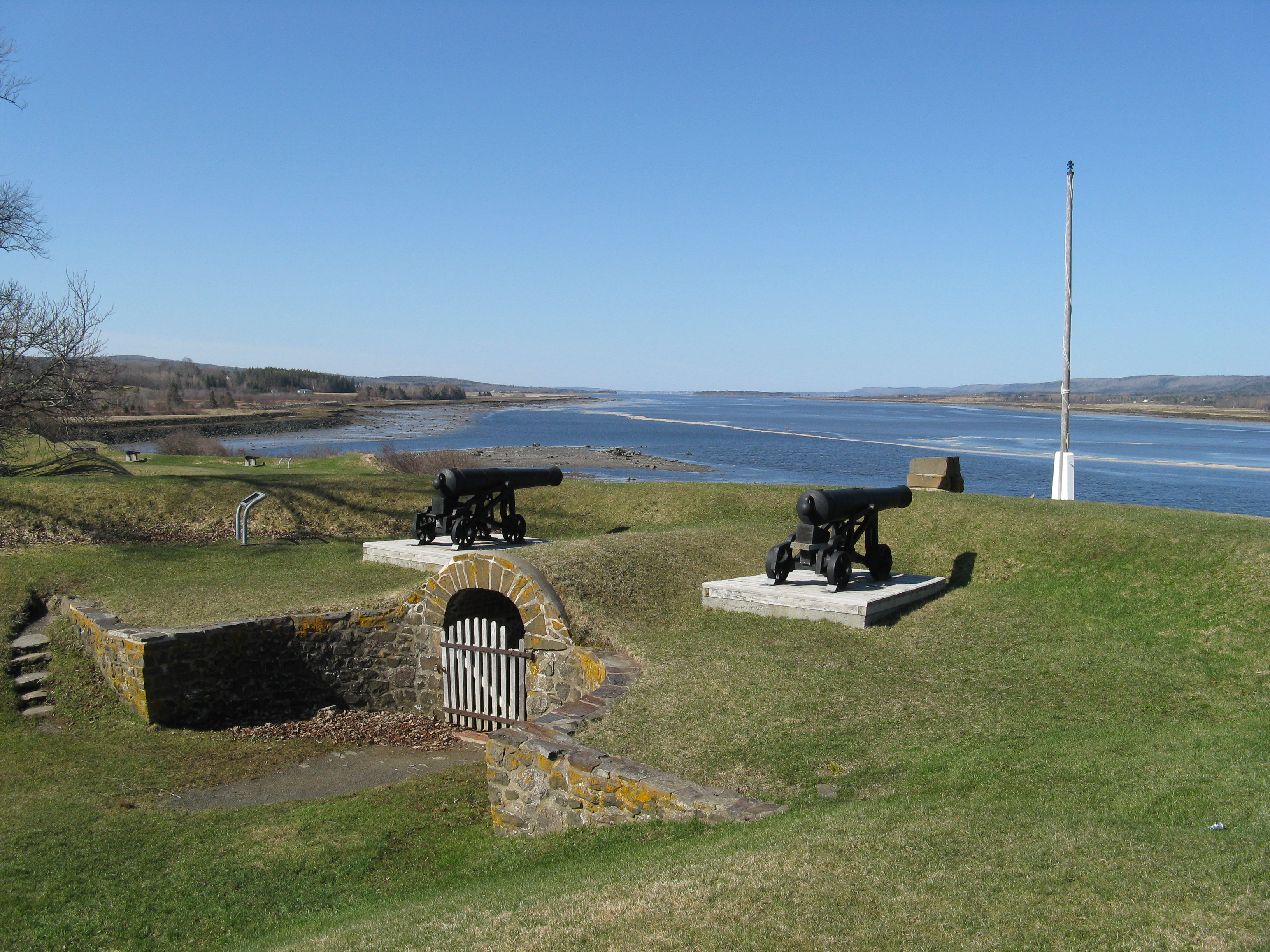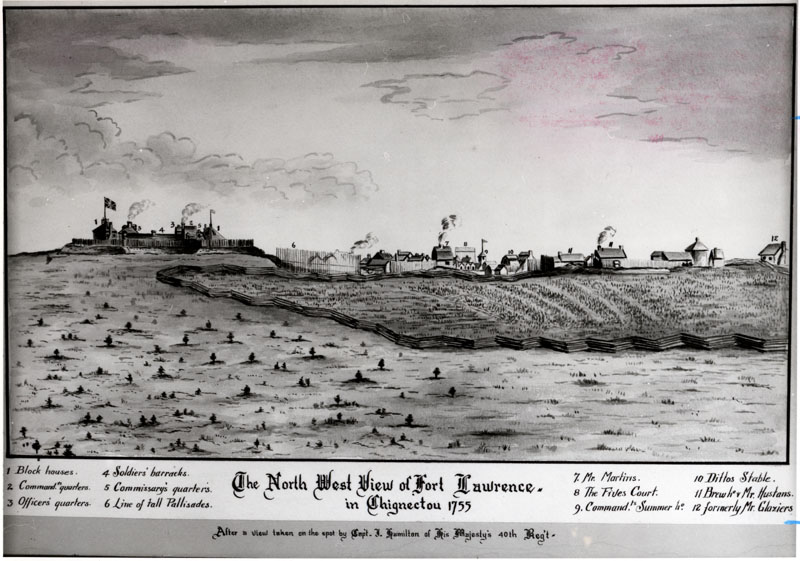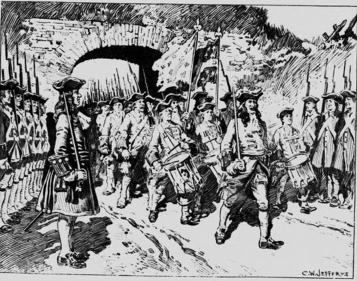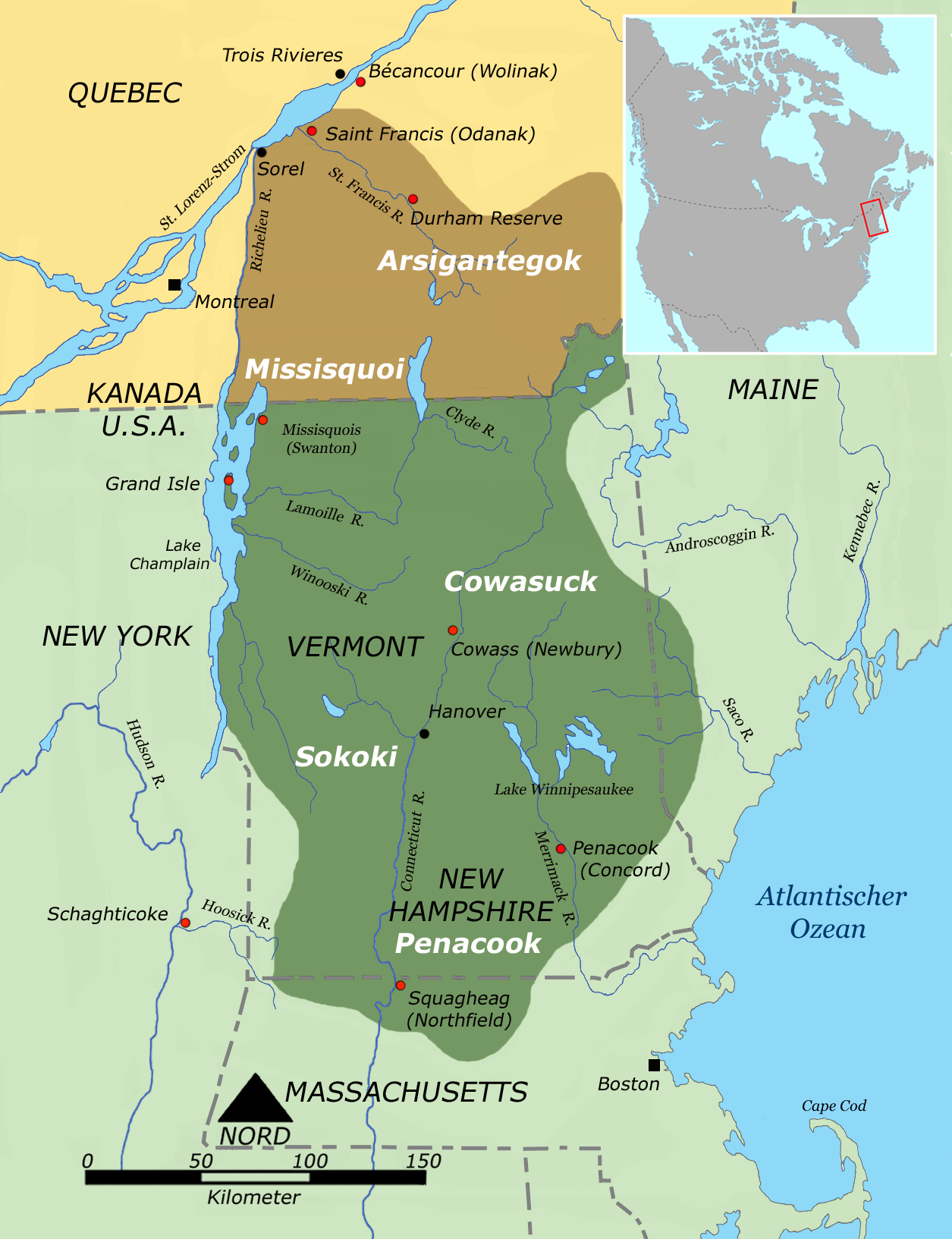|
Fort Anne
Fort Anne (first established in 1629 as the Scottish Charles Fort) is a four-bastion fort built to protect the harbour of Annapolis Royal, Nova Scotia. The fort repelled all French attacks during the early stages of King George's War. Now designated a National Historic Site of Canada, it is managed by Parks Canada. Two buildings remain intact: * The 1708 stone powder magazine in Bourgogne Bastion * The 1797 Officer's Quarters was renovated in the 1930s and now house the museum with exhibits about the fort's history and historic artifacts from the area. It was former site of two separate structures: Governor's house and chapel. Other structures were replaced by later work by British: * Bake house in Dauphin Bastion later became underground magazine * Powder magazine in Berry Bastion now vacant Lieutenant Governor house and dry storage building in front of current officers quarters demolished. Currently vacant area. A trail runs along the fort's earthen walls, and provides a ... [...More Info...] [...Related Items...] OR: [Wikipedia] [Google] [Baidu] |
Annapolis Basin
The Annapolis Basin is a sub-basin of the Bay of Fundy, located on the bay's southeastern shores, along the northwestern shore of Nova Scotia and at the western end of the Annapolis Valley. The basin takes its name from the Annapolis River, which drains into its eastern end at the town of Annapolis Royal. The basin measures approximately northeast-southwest and at its widest from northwest to southeast. It is a sheltered and mostly shallow water body, framed by the ridges of the North Mountain and South Mountain ranges of the Annapolis Valley; the basin is geologically a continuation of the valley floor. A break in the North Mountain range at the northwestern edge of the basin, called Digby Gut, provides an outlet to the Bay of Fundy. The Bay Ferries Limited ferry service operating across the Bay of Fundy between Digby and Saint John maintains a terminal on the western shore of the basin near the Digby Gut. Rivers Rivers which drain into the basin include: * Annapolis ... [...More Info...] [...Related Items...] OR: [Wikipedia] [Google] [Baidu] |
Treaty Of Utrecht
The Peace of Utrecht was a series of peace treaties signed by the belligerents in the War of the Spanish Succession, in the Dutch city of Utrecht between April 1713 and February 1715. The war involved three contenders for the vacant throne of Spain, and involved much of Europe for over a decade. The main action saw France as the defender of Spain against a multinational coalition. The war was very expensive and bloody and finally stalemated. Essentially, the treaties allowed Philip V (grandson of King Louis XIV of France) to keep the Spanish throne in return for permanently renouncing his claim to the French throne, along with other necessary guarantees that would ensure that France and Spain should not merge, thus preserving the balance of power in Europe. The treaties between several European states, including Spain, Great Britain, France, Portugal, Savoy and the Dutch Republic, helped end the war. The treaties were concluded between the representatives of Louis XIV of Fra ... [...More Info...] [...Related Items...] OR: [Wikipedia] [Google] [Baidu] |
Fort Lawrence
Fort Lawrence was a British fort built during Father Le Loutre's War and located on the Isthmus of Chignecto (in the modern-day community of Fort Lawrence). Father Le Loutre's War Despite the British Conquest of Acadia in 1710, Nova Scotia remained primarily occupied by Catholic Acadians and Mi'kmaq. Father Le Loutre's War began after Edward Cornwallis arrived to establish Halifax with 13 transports on June 21, 1749. The British quickly began to build other settlements. To guard against Mi'kmaq, Acadian and French attacks on the new Protestant settlements, British fortifications were erected in Halifax (1749), Bedford ( Fort Sackville) (1749), Dartmouth (1750), Lunenburg (1753), and Lawrencetown (1754). Within 18 months of establishing Halifax, the British also took firm control of peninsula Nova Scotia by building fortifications in all the major Acadian communities: present-day Windsor ( Fort Edward); Grand-Pré ( Fort Vieux Logis) and Chignecto (Fort Lawrence). A Brit ... [...More Info...] [...Related Items...] OR: [Wikipedia] [Google] [Baidu] |
Father Le Loutre's War
Father Le Loutre's War (1749–1755), also known as the Indian War, the Mi'kmaq War and the Anglo-Mi'kmaq War, took place between King George's War and the French and Indian War in Acadia and Nova Scotia. On one side of the conflict, the British and New England colonists were led by British officer Charles Lawrence and New England Ranger John Gorham. On the other side, Father Jean-Louis Le Loutre led the Mi'kmaq and the Acadia militia in guerrilla warfare against settlers and British forces. At the outbreak of the war there were an estimated 2500 Mi'kmaq and 12,000 Acadians in the region. While the British captured Port Royal in 1710 and were ceded peninsular Acadia in 1713, the Mi'kmaq and Acadians continued to contain the British in settlements at Port Royal and Canso. The rest of the colony was in the control of the Catholic Mi'kmaq and Acadians. About forty years later, the British made a concerted effort to settle Protestants in the region and to establish military ... [...More Info...] [...Related Items...] OR: [Wikipedia] [Google] [Baidu] |
Taken On The Spot By Capt
Taken may refer to: People * Floris Takens (1940-2010), Dutch mathematician Arts, entertainment, and media ''Taken'' film and television franchise * ''Taken'' (franchise), a trilogy of action films starring Liam Neeson ** ''Taken'' (film), the first film in the trilogy ** ''Taken'' (2017 TV series), an American television series which acts as an origin story of Bryan Mills ** '' Taken: The Search for Sophie Parker'', a 2013 made-for-TV film Film *''Taken'', a 1999 film featuring Michael Rudder * ''Taken'', a Flash animation by Adam Phillips Television * ''Taken'' (2016 TV series), a Canadian true crime documentary series * ''Taken'' (miniseries), a 2002 American science fiction miniseries * "Taken" (''Alias''), an episode of ''Alias'' * "Taken" (''Arrow''), an episode of ''Arrow'' * "Taken" (''Law & Order: Special Victims Unit''), an episode of ''Law & Order: Special Victims Unit'' Literature * ''Taken'' (novel), a 2001 novel by Kathleen George * ''Taken'' (Rober ... [...More Info...] [...Related Items...] OR: [Wikipedia] [Google] [Baidu] |
Battle At Winnepang (Jeddore Harbour)
The Battle of Winnepang occurred during Dummer's War when New England forces attacked Mi'kmaq at present day Jeddore Harbour, Nova Scotia. The naval battle was part of a campaign ordered by Governor Richard Philipps to retrieve over 82 New England prisoners taken by the Mi'kmaq in fishing vessels off the coast of Nova Scotia. The New England force was led by Ensign John Bradstreet and fishing Captain John Elliot. Historical context Dummer's War occurred as a result of an expansion of British settlements along the Kennebec River (in present-day Maine) and of the movement of more New England fishermen into Nova Scotia waters (particularly at Canso, Nova Scotia). The Treaty of Utrecht (1713), which ended Queen Anne's War, had facilitated this expansion. The treaty, however, had been signed in Europe and had not involved any tribes of the Wabanaki Confederacy. None had been consulted and they protested through raids on British fishermen and settlements. In response to Wabanaki ho ... [...More Info...] [...Related Items...] OR: [Wikipedia] [Google] [Baidu] |
Samuel Shute
Samuel Shute (January 12, 1662 – April 15, 1742) was an English military officer and royal governor of the provinces of Massachusetts and New Hampshire. After serving in the Nine Years' War and the War of the Spanish Succession, he was appointed by King George I as governor of Massachusetts and New Hampshire in 1716. His tenure was marked by virulent disagreements with the Massachusetts assembly on a variety of issues, and by poorly conducted diplomacy with respect to the Native American Wabanaki Confederacy of northern New England that led to Dummer's War (1722–1725). Although Shute was partly responsible for the breakdown in negotiations with the Wabanakis, he returned to England in early 1723 to procure resolutions to his ongoing disagreements with the Massachusetts assembly, leaving conduct of the war to Lieutenant Governor William Dummer. His protests resulted in the issuance in 1725 of the Explanatory Charter, essentially confirming his position in the disputes with ... [...More Info...] [...Related Items...] OR: [Wikipedia] [Google] [Baidu] |
John Doucett
John Doucett (Doucette) (died November 19, 1726) was probably of French descent although he did not speak the language and was likely born in England. He was a career military man and, from 1702 on, received several promotions. He was appointed lieutenant-governor of Annapolis Royal in May, 1717 and arrived in Nova Scotia in October. He was also acting on behalf of Richard Philipps, the new governor of Nova Scotia who was still in England. He administered the government there from 1717 to 1720 and was lieutenant-governor of Annapolis Royal, N.S. from 1717 to 1726. He was active and visible in both capacities, working to improve relations between the British and French colonists, to minimize smuggling and fisheries encroachment, and to secure a lasting peace between the various Indian chiefs and the government. He had some noteworthy successes, particularly securing a ratified peace with the First Nations at the close of Dummer's War Dummer's War (1722–1725) is also known as F ... [...More Info...] [...Related Items...] OR: [Wikipedia] [Google] [Baidu] |
Mi'kmaq People
The Mi'kmaq (also ''Mi'gmaq'', ''Lnu'', ''Miꞌkmaw'' or ''Miꞌgmaw''; ; ) are a First Nations people of the Northeastern Woodlands, indigenous to the areas of Canada's Atlantic Provinces and the Gaspé Peninsula of Quebec as well as the northeastern region of Maine. The traditional national territory of the Mi'kmaq is named Miꞌkmaꞌki (or Miꞌgmaꞌgi). There are 170,000 Mi'kmaq people in the region, (including 18,044 members in the recently formed Qalipu First Nation in Newfoundland.) Nearly 11,000 members speak Miꞌkmaq, an Eastern Algonquian language. Once written in Miꞌkmaw hieroglyphic writing, it is now written using most letters of the Latin alphabet. The Mi'kmaq, Maliseet, and Pasamaquoddy nations signed a series of treaties known as the Covenant Chain of Peace and Friendship Treaties with the British Crown throughout the eighteenth century; the first was signed in 1725, and the last in 1779. The Miꞌkmaq maintain that they did not cede or give up the ... [...More Info...] [...Related Items...] OR: [Wikipedia] [Google] [Baidu] |
Abenaki People
The Abenaki ( Abenaki: ''Wαpánahki'') are an Indigenous peoples of the Northeastern Woodlands of Canada and the United States. They are an Algonquian-speaking people and part of the Wabanaki Confederacy. The Eastern Abenaki language was predominantly spoken in Maine, while the Western Abenaki language was spoken in Quebec, Vermont, and New Hampshire. While Abenaki peoples have shared cultural traits, they did not historically have a centralized government. They came together as a post-contact community after their original tribes were decimated by colonization, disease, and warfare. Names The word ''Abenaki'' and its syncope, ''Abnaki,'' are both derived from ''Wabanaki'', or ''Wôbanakiak,'' meaning "People of the Dawn Land" in the Abenaki language. While the two terms are often confused, the Abenaki are one of several tribes in the Wabanaki Confederacy. The name is spelled several ways including Abnaki, Abinaki, and Alnôbak. ''Wôbanakiak'' is derived from ''wôban ... [...More Info...] [...Related Items...] OR: [Wikipedia] [Google] [Baidu] |
Father Rale's War
Dummer's War (1722–1725) is also known as Father Rale's War, Lovewell's War, Greylock's War, the Three Years War, the Wabanaki-New England War, or the Fourth Anglo-Abenaki War. It was a series of battles between the New England Colonies and the Wabanaki Confederacy (specifically the Miꞌkmaq, Maliseet, Penobscot, and Abenaki), who were allied with New France. The eastern theater of the war was located primarily along the border between New England and Acadia in Maine, as well as in Nova Scotia; the western theater was located in northern Massachusetts and Vermont at the border between Canada (New France) and New England. During this time, Maine and Vermont were part of Massachusetts.The Nova Scotia theater of the Dummer War is named the "Mi'kmaq-Maliseet War". John Grenier. ''The Far Reaches of Empire: War in Nova Scotia 1710-1760''. University of Oklahoma Press. 2008. The root cause of the conflict on the Maine frontier concerned the border between Acadia and New England, whic ... [...More Info...] [...Related Items...] OR: [Wikipedia] [Google] [Baidu] |





